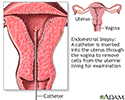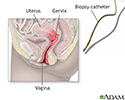Endometrial biopsy
Biopsy - endometrium
Endometrial biopsy is the removal of a small piece of tissue from the lining of the uterus (endometrium) for examination.
How the Test is Performed
This procedure may be done with or without anesthesia. This is medicine that allows you to sleep during the procedure.
- You lie on your back with your feet in stirrups, similar to having a pelvic exam.
- Your health care provider gently inserts an instrument (speculum) into the vagina to hold it open so that your cervix can be viewed. The cervix is cleaned with a special liquid. Numbing medicine may be applied to the cervix.
- The cervix may then be gently grasped with an instrument to hold the uterus steady. Another instrument may be needed to gently stretch the cervical opening if there is tightness.
- An instrument is gently passed through the cervix into the uterus to collect the tissue sample.
- The tissue sample and instruments are removed.
- The tissue is sent to a lab. There, it is examined under a microscope.
- If you had anesthesia for the procedure, you are taken to a recovery area. Nurses will make sure you are comfortable. After you wake up and have no problems from the anesthesia and procedure, you are allowed to go home.
How to Prepare for the Test
Before the test:
- Tell your provider about all the medicines you take. These include blood thinners such as warfarin, clopidogrel, and aspirin.
- You may be asked to have a test to make sure you are not pregnant.
- In the 2 days before the procedure, do not use creams or other medicines in the vagina.
- Do NOT douche. (You should never douche. Douching can cause infection of the vagina or uterus.)
- Ask your provider if you should take pain medicine, such as ibuprofen or acetaminophen, just before the procedure.
How the Test will Feel
The instruments may feel cold. You may feel some cramping when the cervix is grasped. You may have some mild cramping as the instruments enter the uterus and the sample is collected. The discomfort is mild, though for some women it can be severe. However, the duration of the test and the pain are short.
Why the Test is Performed
The test is done to find the cause of:
- Abnormal menstrual periods (heavy, prolonged, or irregular bleeding)
- Bleeding after menopause
- Bleeding from taking hormone therapy medicines
- Thickened uterine lining seen on ultrasound
- Endometrial cancer
Normal Results
The biopsy is normal if the cells in the sample are not abnormal.
What Abnormal Results Mean
Abnormal menstrual periods may be caused by:
- Uterine fibroids
- Fingerlike growths in the uterus (uterine polyps)
- Infection
- Hormone imbalance
- Endometrial cancer or precancer (hyperplasia)
Other conditions under which the test may be performed:
- Abnormal bleeding if a woman is taking the breast cancer medicine tamoxifen
- Abnormal bleeding due to changes in hormone levels (anovulatory bleeding)
Risks
Risks for endometrial biopsy include:
- Infection
- Causing a hole in (perforating) the uterus or tearing the cervix (rarely occurs)
- Prolonged bleeding
- Slight spotting and mild cramping for a few days
References
Beard JM, Osborn J. Common office procedures. In: Rakel RE, Rakel DP, eds. Textbook of Family Medicine. 9th ed. Philadelphia, PA: Elsevier Saunders; 2016:chap 28.
Soliman PT, Lu KH. Malignant diseases of the uterus: endometrial hyperplasia, endometrial carcinoma, sarcoma: diagnosis and management. In: Gershenson DM, Lentz GM, Valea FA, Lobo RA, eds. Comprehensive Gynecology. 8th ed. Philadelphia, PA: Elsevier; 2022:chap 32.
Female reproductive anatomy - illustration
Female reproductive anatomy
illustration
Endometrial biopsy - illustration
Endometrial biopsy
illustration
Uterus - illustration
Uterus
illustration
Endometrial biopsy - illustration
Endometrial biopsy
illustration
Review Date: 7/13/2021
Reviewed By: John D. Jacobson, MD, Department of Obstetrics and Gynecology, Loma Linda University School of Medicine, Loma Linda, CA. Also reviewed by David Zieve, MD, MHA, Medical Director, Brenda Conaway, Editorial Director, and the A.D.A.M. Editorial team.










